|
|
Horror DVDs on a budget
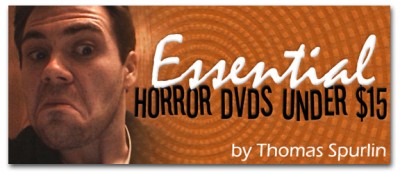 "A thousand fearful images and dire suggestions glance along the mind when it is moody and discontented with itself. Command them to stand and show themselves, and you presently assert the power of reason over imagination". -- Sir Walter Scott
"A thousand fearful images and dire suggestions glance along the mind when it is moody and discontented with itself. Command them to stand and show themselves, and you presently assert the power of reason over imagination". -- Sir Walter Scott
Ahh, the month of October. Weather's getting colder, the landscape's growing orange with the falling leaves, and the ghouls, gremlins, and ghastly grotesqueries of All Hallow's Eye have begun to peek out from their crafty little hiding places. As a big Halloween buff, I start to get a little giddy once the jack-o-lanterns and scarecrows start to pop up at the beginning of the month. It's a time for hunting down haunted houses and donning outrageous get-ups like witch's cloaks and vampire's teeth, sure, but there's one other thing that requires little effort -- outside of inviting friends and family over and whipping up a little popcorn -- that'll get the holiday mood really going: a horror movie marathon. Ghost stories, slasher flicks, psycho mysteries, creature features ... the bigger the goosebumps, the better the mood gets.
But let's face it; there's a large number of horror movies out there that step beyond the boundaries of pure shock cinema and gore lavishness -- films that don't require a certain "horror mood" to soak them in. Instead, these are tense movies that just hit the nail on the head as GREAT pieces of cinema, period, such as Ridley Scott's Alien and Alfred Hitchcock's Psycho. Human themes come up in these multifaceted films, like the pressure of authoritative figures and morality concepts, to such a degree that they begin to blur the lines of genre. That's a good horror film in my eyes, which reflects heavily in most of my recommendations; though, don't get me wrong, there's a soft spot in me for the typical run-of-the-mill furious thrillrides where the corn syrup and silicone appendages start to fly.
It's more a matter of thought, though -- the more I'm forced to mull over a specific piece of work, the more it leaves an imprint on my growingly-weathered cinematic core. Too much blood without enough brains typically dwindles my attention, which understandably differs from a large chunk of the genre's populace that relish in diving head-first into pure slice-n'-dice mayhem. That might make a stubborn fan with limited range out of me -- but, hey, that's the beauty of personal preference and the concept of "different strokes for different folks", right? Instead, it makes the process of searching for genre-bending films filled with social insight an ardent hit-and-miss task, but one that provides ecstatic moments in finding that handful of rewarding discoveries. But it takes a few bad eggs, however, to find ones with longevity and quality. During a time when gas prices fluctuate with the weather and the prices of fresh produce and necessary groceries constantly escalate, it's a lot less fun to invest in one of such "misses".
Fear not; it's Halloween, you've got limited cash to spend in your pocket on a few horror DVDs, and you'd like some sure-fire inexpensive suggestions that carry lasting appeal. What are some substantial, effective horror films that will squeeze the most out of your hard-earned change? Below is a list of some firmly recommended Essential Horror DVDs Under $15. Bear in mind that all the items on this list are suggested-price $15 and below -- therefore, you should be able to nail them down for significantly less. Also, remember that these are opinions based on this reviewer's zany outlook on film, and do not represent DVDTalk's interpretation of "essential" as a whole. But enough of that jazz:
American Psycho
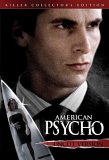

Quick Notes on the DVD:
Lions Gate's Killer Collector's Edition has a sharp 2.35 image, solid Dolby 5.1 sound, and slick extras encapsulating the then-hard-to-find Uncut version of the film.
DVDTalk Review
|
Just think: the crown jewel in Christopher Nolan's Batman films, Christian Bale, got his catalytic spark in American Psycho, a grand horror critique that displays the actor in a role that completely epitomizes every single negative aspect of the world that the Caped Crusader defends. Though it spaces its bloodshed out very wide across its length, Mary Harron's adaptation of an equally critical novel crafts a thought-provoking and dynamically atmosphere amid its satirical tone -- one that makes its critiques even more frightening than its direct scares. Reservations at Dorsea, battles over business cards, and the superficial routine of Patrick Bateman's shell of a man all help to construct American Psycho into a farce that truly fuels the intellect.
I think it's great that many men aspire to have the body and essence of Patrick Bateman; essentially, they're prescribing to at least a pinch of the narcissism that the film slams so hard. American Psycho, an overwhelming neophyte rollercoaster surprisingly adapted by female director Harron, is a stronger social analysis than it is blatant horror film. Consider the fact that Bale serves up an infinitely intriguing anti-heroic monster as the lackadaisical Wall Street monger crazed by a thirst for blood, and think about economic turmoil in modern society. The parallels are staggering, boundless even. How a horror film introduces the ideal of destruction as a way of satisfying a socialite's ability to want for not, let alone the overall level of dishonesty and crassness within the elite's network, is a work of intricate genius.
|
Wedged in between Cronos and Pan's Labyrinth, along with that other devil-hero action flick, Del Toro's Spanish Civil War ghost story Devil's Backbone makes the absolute most out of walking that fine line between haunting drama and smooth paranormal tension. It's the story of a boy's orphanage / school during the '30s that has been plagued with a cursed boy haunting its lower levels. Though it becomes the main plot device, that's aside from other focal intriguing elements in the film; the imagery present in a nose-first bomb that, by thr hands of fate, didn't explode in the center of the schoolyard, as well as the trauma surrounding the war's horrendous psychological effects, also add sparks of eerie symbolism.
Del Toro's rise to notoriety as a prolific orchestrator of fantasy with Pan's Labyrinth has rustled up interest in his back catalogue, a roster of films strongly highlighted by Devil's Backbone. Following the path from Cronos to his current talents is surprisingly clear; his style took a rather large jump in focus as he began work on Devil's Backbone, one refined with strong competence in adult acting but even more solidly latched onto pulling fantastic performances from child actors. They interweave within the historical atmosphere seamlessly, taking you into '30s Spain effortlessly with exquisite cinematography from Del Toro's mainstay cinematographer Eduardo Navarre -- also responsible for work that stretch from Tarantino's Jackie Brown to Favreau's Zathura. What results is a beautiful paranormal story, one that rides a rollercoaster path between dramatic beauty and slow-burning eeriness.
|
The Devil's Backbone


Quick Notes on the DVD:
Sony (Columbia / Tri-Star)'s Special Edition of The Devil's Backbone comes springloaded with exquisite Dolby 5.1 sound and 1.85 picture, but the highlight comes in a wide array of supplemental materials that include a Del Toro commentary. Just don't let the corny "From the Director of Hellboy" statement on the cover guide your perception of the film.
DVDTalk Review
|
Hard Candy


Quick Notes on the DVD:
Lions Gate's Special Edition of Hard Candy sports a ferocious 2.35 transfer, fittingly atmospheric Dolby 5.1 audio track, and a cornucopia of special features that includes a near hour-long assembly documentary and a duo of commentaries.
DVDTalk Review
|
Before she blurted out kitschy dialogue in the slick preggo-comedy Juno, Ellen Page embodied the nefarious Hayley Stark -- a role in Hard Candy that renders her as a much more frightening threat to masculine energy. David Slade's taut thriller finds an unnervingly-orchestrated blend between similar themes in Takashi Miike's Audition with the grim mood and symbolism found in the Little Red Riding Hood fable. It's a brutal turning of tables that features two people and, aside from one or two interruptions, two people alone: Jeff, an early-30s photographer with an eye for young girls, and Hayley, an "innocent" 14 year-old girl with a deep thirst for vengeance.
Hard Candy escalates into a rat's nest of nerves inside Jeff's angular, clean-cut apartment, which establishes a beautiful environment for photographing a very ugly situation. 30 Days of Night photographer Jo Willems shows an early effort in chilling cinematography that's rife with clean lines and solid colors in a growingly ambiguous atmosphere. But it's within Ellen Page and Patrick Wilson's dynamic rapport that its energy rages from the second that their connection is established. When this tense environment reaches its boiling point, Hard Candy becomes a provocative and somewhat controversial film once the true horror elements begin to spurt out once its surgically-placed bloodshed oozes into the picture.
|
Isn't it fascinating how crappy remakes can further accentuate classics, especially in the horror genre? There are few gaps in quality as far wide as the difference between the '99 computer-generated eyesore and the classic 1963 version of The Haunting -- one sports a singular popcorn element that makes it digestible, while the other provides so many accuracies revolving around the genre that it's hard to pick just one. Setup is simple: four people, one of which is a professor, spend a prolonged period of time in the dreaded Hill House, a labyrinthine mansion that seems engineered for the sheer purpose of losing people in its echoic corridors. Considering the lineage of the owner, that might not be too far from the truth.
Few black-and-white horror films display the kind of architecturally-gripping cinematography that The Haunting displays, which is really saying something. Winding around the corners of this place behind Eleanor, a batty ball of nerves with a troubling past, helps to craft the infinite-seeming expanses of the mansion. A lot of the maddening atmosphere is created by Eleanor's internal dialogue, a stream of consciousness from our perspective character's brain that rattles the cage quite a bit in between the scenes where slight paranormal activity arises. But it's when all's still, immobile, and rife for hearing every ounce of sound surrounding the room that Robert Wise's paranormal psyche-out ramps up. The scares are spread out, thumping and spiking a lot like a heart beat; once again, possibly more accurate than not considering the house itself might just be alive.
|
The Haunting (1963 Original)


Quick Notes on the DVD:
Considering it's an early '60s B&W horror film, The Haunting's 2.35 image and mono audio track from WB suit its purposes just fine -- but the supplements, including a cast commentary, really get it right.
DVDTalk Review
|
High Tension: Unrated
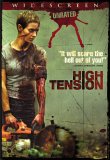

Quick Notes on the DVD:
Lions Gate's "Unrated" Edition of High Tension, running at a shade underneath 91 minutes, is the intended unbutchered cut of the flick. In that, this DVD also has the original French language track in 5.1 Dolby, along with a sublimely grimy and detailed 2.35 image. It's also got an apt director commentary / making-of pairing to supplement.
DVDTalk Review
|
Also known by its French translation Haute Tension and the spiffy alt-title Switchblade Romance, Alexandre Aja's fantastic mind-bender High Tension is better known by its signature weapon -- the steel-barbed mace -- than its head-splitting twisted nature. Not that the film's by any means weak to any degree, just that the conception of this brutal instrument gives horror fans an iconic weapon that proudly sits next to the likes of Jason's machete, Freddie's knife-fingers, and Leatherface's chainsaw. Even more enjoyable is the fact that it's being wielded in the hands of Marie, a female college student on a study vacation with her friend in a quaint farmhouse in the middle of nowhere.
Though that's the root of its wider recognition, High Tension maintains its reputation as a brutal, disturbing horror film by taking the "trapped school girls" mechanic and spiking the anxiety up quite a few decibels. Maybe it's because of its influences, such as Tobe Hooper's Texas Chainsaw Massacre, that it thrashes on the nerves. It doesn't do anything spectacularly out of the norm throughout its core, but it handles both backwater isolation and claustrophobic terror with far-above average precision and grittiness. But then, after wreaking havoc on our nerves in expertly-assembled horror film fashion, High Tension spins one of the more convoluted plot twists I've had the pleasure of getting wide-eyed and open-jawed at. It's a bloody and brutal shot to the stomach that proves enough of a challenging atmosphere to make you want to take the ride all over again.
|
In the late '60s, American concern with atomic radiation continued to escalate amid endless military involvements. George Romero, a genius in applying realistic fear into his audience, harnessed this mania in Night of the Living Dead, referencing this radiation as being the core cause of all the pandemonium hogging all the on-screen attention. It might not seem as intensely thematic as the starkly-opposing entities present in the hideout -- namely the weathered, street-savvy black hero, and the scared-witless blonde victim -- or the incredible usage of claustrophobia as the monsters build momentum and numbers towards the hideout, but the threat of an element as questionable and ill-researched at the time as nuclear radiation made sure to, and still does, give off a haunting aura of topical immediacy.
Holistically, this focal house is one of the stronger experimental grounds of fight-or-flight instinct that surround a topical man-made threat in the horror genre -- or in film as a whole. And to think that Romero made this flick with a nickels-in-a-jar budget. Romero's first zombie flick is a classic among horror classics for inventive resourcefulness, but also for its capacity to be thought-provoking within its terrifying properties. It has also become legendary because of one of the better usages of cheap prop-work to that point: the fantastic initial shot of the house's bloody, gap-toothed dead inhabitant. Even now, that shot in Night of the Living Dead rustles up a chill or two.
|
Night of the Living Dead: 40th Anniversary


Quick Notes on the DVD:
The Weinstein Co's Tenth-Anniversary edition of Night of the Living Dead looks great in its original 1.33 black-and-white transfer, while also sounding surprisingly robust and clear in its Dolby 5.1 track -- though a mono track's available for purists. Extras are also stacked, as it carries over the Romero & Co. commentary from older releases and adds a huge doc on top of that.
DVDTalk Review
|
Rosemary's Baby


Quick Notes on the DVD:
For a disc of its age, Paramount's copy of Rosemary's Baby really doesn't look all that bad in its 1.66 image -- but, on the other hand, it is in desperate need of a new-generation spit shine. The stereo track is, however, a little strained, while the extras consist of a few interviews. Bottom line: worthwhile for the price, since the film's so good.
DVDTalk Review
|
Ah, you've got to love Roman Polanski's way with human interaction. He has so much fun making his audience feel uncomfortable while they watch his characters fumble between themselves, such as with The Tenant and Knife in the Water. When he infuses Rosemary's Baby, a film riddled with equal Polanski flavor, with the radiant Mia Farrow, it creates a warmer environment for the film's initial moments. She's cast perfectly as the gentle maternally-driven housewife, which really helps once Polanski's film flies off the handle and becomes an exercise in unnerving discomfort. It's funny how such discomfort can seem so natural and ... comfortable.
Part of soaking in Rosemary's Baby arises in taking in the rich architecture of the luxurious -- albeit echoic -- New York apartments. It's a domestic horror film, a common thread in several of Polanski's films, one captured in some rather beautiful set designs that craft a haunting atmosphere amid tall ceilings and expansive, hollow rooms. It's all a clever ploy; Rosemary's Baby lures its audience into its mannerisms, nudging them along with developing paternal instincts towards a barrage of disturbing dream imagery. Oh, but then it begins to radiate evil as the lead grows more pregnant and less healthy, and Polanski's horror masterwork really pushes forward with making skin crawl. There's something splendid about seeing Mia Farrow's bright-eyed Rosemary as she's sent through the gauntlet of despondency, a demeanor heightened by its gradual guidance into a world of erratic madness.
|
It all started with one claustrophobic horror flick funded on a little over a million bucks. The original Saw created quite a stir with its gruesome nature and one hell of an ending. Since Shyamalan came out with his little PG-13 horror treats -- all adorning a spin on the narrative at the end -- many filmmakers had been rustling up twist endings left and right, some effective, some not. With Leigh Whannell's interwoven script and James Wan's sturdy direction that primed each shot for hack-n-slash editing, they formulated a film more sliced up than a ransom note -- and equally as shocking. Saw, though a singularly focused horror film with a very weak grasp on dialogue, comes spring-loaded to shock its audience with brutality amid its atmosphere. But that's only part of the puzzle in Saw. The other portion revolves around the Jigsaw Puzzle killer's motive: to frighten off-kilter people into living a straight-edged life.
The original Saw fits the bill of a modern horror classic; it transforms into a claustrophobic little brainteaser that has a bloody blast in playing a "will they, won't they" guessing dynamic inside Jigsaw's little chess game. His game? Let's just say it involved a pair of saws and a pair of shackled ankles and leave it for you to discover Saw's evil little mind tricks. In concept, it's about as intricate and momentum building as a machine; when spoken, sure, it comes across as a little less sharp than it should. Even when slighted by scriptural shenanigans and waning performances, they're still a hell of a lot better than many, many horror flicks. Plus, it's got Cary Elwes and Danny Glover in enjoyably-performed roles -- not to mention Michael Emerson in an early screen role before he became popular as Ben Linus in Lost. Add in these dashes of personality to 2004's surprise indie torture thriller, and you've got a winner.
|
Saw: Uncut


Quick Notes on the DVD:
Lions Gate's two-disc edition of Saw comes packed to the gills, showing off a razor-sharp 1.85 transfer and an equally snappy DTS-ES 6.1 aural get-up. Supplements are loaded, containing a series of commentaries, storyboard & art sequences, and the original Saw short film.
DVDTalk Review
|
Session 9


Quick Notes on the DVD:
USA / Universal's Session 9 disc comes with a serviceable 2.35 transfer to match the more potent Dolby 5.1 audio option, while the supplements contain a Brad Anderson commentary, some storyboard materials, etc.
DVDTalk Review
|
There's a surprisingly small number of films that use haunted mansions, hospitals, and other gothic-shaped structures nowadays. Why filmmakers don't tap into these naturally frightening structures is beyond me; one recent flick that does is Session 9, a psycho-paranormal thriller from director Brad Anderson. He focuses on this incredible bat-shaped hospital that requires an asbestos-sweep crew for cleansing, which is heavily ironic considering the fact that much more needs to be purged from this horrible place than that. Of course, as we twist and wind around every corner of this structure, images of peeling paint and dilapidated session chambers rely on their own natural properties to evoke quite a chilling atmosphere.
Led by David Caruso, Session 9 slyly introduces the audience to a host of blue-collar cleaners driven by testosterone, money, and for-the-moment satisfaction. Their personalities are surprisingly distinct, creating a strange dynamic that neither makes them out to be appealing or villainous. Much like average humans, there's bits and pieces from both sides of the spectrum in these guys hired to flush this hotbed of horrible memories of its filth. Once one of them disappears in the corridors of the asylum, it becomes a downward spiral of bizarre whodunit mindplay. When its chaos begins to intertwine with the sound of eerie tapes that illustrate one of the patient's horrific schizophrenia, Session 9 becomes a balancing act between wondering whether it's the haunted structure's fault for swallowing up one of the cleaners or whether it's something orchestrated by these regular guys -- or a combination of both.
|
Like a stream of gruesome stories told by the Manson family, Three ... Extremes gathers together a trio of Asia's most talented directors -- Park Chan-wook, Takashi Miike, and Fruit Chan -- and assembles a potent collage of starkly different styles and verbal rhythms. These directors, along with their films, share very little in common aside from one thing: recognition due their signature, bizarrely singular styles. At over two hours of lush photography and sinister motivations and grotesqueries, this is one of the more paramount onslaughts of differentiated styles that you can get encapsulated in one film -- one that'll haunt and disturb in ways that only each director knows how to instill.
Of course, Miike's Lynchian-esque ghost story Box and Park Chan-wook's Cut, an exercise in thematic trap-torture cinema, are both phenomenal -- I wouldn't expect any less from the directors behind Audition and Oldboy respectfully; however, Fruit Chan's Dumplings stood out with more resonance in my last viewing than it has in past viewings. Perhaps it's because I went in expecting to see it as the weakest addition, but for some reason it really worked this time through. It blends a long stream of grotesque eating / preparing scenes of odd "health-enhancing" dumplings, while pairing it with themes revolving around society's thirst for immortality and vanity. As the preparer of these treats, Bai Ling captures attention in much the same sinister ways that she does in The Crow and in an appearance in TV's Lost. But, boy, watching Miriam Yeung Chin Wah consume those little, erm, disgusting treats has the same effect as it always has: indulgent, overused, but still very squirm-inducing with each bite.
|
Three ... Extremes
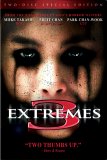

Quick Notes on the DVD:
Lions Gate's two-Disc edition carries the best of the transfers for the film, looking sharp and properly detailed in its 1.85 image. The edge, however, goes to the MediaAsia edition for a quality DTS track, though LG's Dolby track is no slouch. Extras are a toss-up if you pick up the two-disc Media Asia for comparison, but the Lion's Gate has a nice subtitled commentary with Miike and the full-length cut of Dumplings on Disc 2.
DVDTalk Review
|
Honorable Mention:
Audition
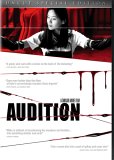

Quick Notes on the DVD:
Sadly, the reason this Uncut edition doesn't make it to the top of the essentials list isn't because of the film's quality -- but because of a piss-poor transfer. Color and mild details are the only things relatively decent in Audition's PAL > NTSC, interlaced transfer. Audio's fine, and the supplements are decent, but the visual presentation detracts a bit from the film.
If it would've been a proper NTSC rendering and not as murky / blurry as watching it through a fog blanket, then it'd skyrocket to the top of this list. If you don't have access to a PAL player, then this is a decent purchase; however, if PAL playback is possible, then hunt down the UK Tartan disc.
DVDTalk Review
|
Japanese director Takashi Miike has been branded one of the genre's most morbid and gripping auteurs for many reasons, but the primary one comes packaged in a blood-soaked, barbed-wire little firecracker entitled Audition. It takes a semi-earnest approach as it follows a widower father as he holds a fake "audition" for his television company in a charade that transforms into a secret "sizing-up" of the women. Of course, he discovers one that he likes -- a soft, innocent, shy little girl who wouldn't harm a hair on a fly's head. As you can guess, that's utter B.S.; essentially, the pristine woman in white takes our focal protagonist -- and everything surrounding them -- into an abyss that leads straight to Hell. It's a film that made me squirm and shake a wee bit when I first saw it, and hasn't ceased in doing the same thing with self-afflicting returns to its fraught demeanor.
Miike's at his best in Ichi the Killer and Gozu when he's operating with outlandish gore and surrealist imagery, both of which play vital roles in Audition. They rarely intersect, though. His different strengths are instead separated throughout most of the film, which allows for a gentle, ambient style of terror to slowly creep behind his audience. But as soon as you're not looking, Asahi, played by Eihii Shiina, give us a reason to spin around rapidly. She's enchanting, unbearable honest in her facial expressions, and quite possibly my most highly-regarded villain in all of horror. The film's kind of like watching a razor-tipped pendulum swinging backwards and forwards; you have a hunch that it's going to lead towards the demise of the person underneath, but you can't help but stare in awe as it swings closer and closer. As Audition quickly begins to unspool at its climax, the look of chaotic disbelief on fresh watchers' faces is the stuff horror legends are made of. Superb acting and taut production values make its improbable constriction in narrative seem much more possible than we'd ever really want it to -- while brandishing returners to its intensity as near-masochists.
|
Archives
|
|


